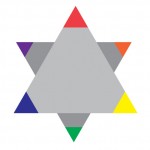Materials Needed
- gouache paints from Supply List
- brushes
- ruler
- t-square
- pencils
- 9×12″ bristol
Lecture
The Elements: basic components used as part of any composition, independent of the medium.
Color
- Hue: Designates the common name of a color, determined by the specific wavelength of a ray of light and/or its position in the spectrum or color wheel.
- Saturation: Refers to the relative purity of a color or its inherent light.
Levels of Saturation- Prismatic Color: As pure a hue as possible with pigments/paint.
- Muted Color: Colors that lie just outside the prismatic zone, created by adding black, white, gray or a complement of a hue.
- Chromatic Gray: Grays that exhibit a subtle, but discernible hue, created by adding larger amounts black, white, gray or a complement of a hue.
- Achromatic Gray: Grays that lack a perceptible hue and saturation.
- Luminosity: Refers to Value; lighter colors are more luminous than darker colors, but a lighter color is not necessarily more saturated.
- Primary Color Triad: Red, Yellow, Blue – three colors that cannot be created from mixtures of hue and when mixed in equal or unequal amounts can produce all possible colors.
- Secondary Color Triad:Orange, Green, Violet – colors created by mixing equal proportions of any two Primary Colors.
- orange (mix red + yellow)
- green (mix yellow + blue)
- violet (mix blue + red)
- Complementary Colors: Colors opposite on the color wheel
- red and green
- yellow and violet
- blue and orange.
Lab
Exploration
- COLOR WORQX – color theory overview
- Color Theory for Designers : The Meaning of Color
Color Triads (FreeStudy)
- Using your ruler, lightly draw two intersecting triangles on a piece of 9″x12″ bristol.
- With your color wheel as a guide, practice mixing and applying colors on a piece of scrap paper, first. Make sure you have achieved the proper hue before applying the paint to paper.
- Then fill in the tips of each triangle with the primary and secondary triads. Do NOT use pre-mixed paint hues. You must mix secondary triads from the primary triad: Red, Yellow and Blue.
- Once you have successfully created the two triad relationships (primary and secondary), further develop your composition and create a FreeStudy!
- Think about what each color might represent: mood, emotion, object.
- Experiment with mixing all three primary colors together, what color is produced?
- What happens when you mix two complementary colors together?
- You may choose to cut out the color swatches and incorporate them with other materials, but make sure your final composition is laid out with a clear connection to the original triads and their placement on the color wheel.
- References:
- Primary, Secondary, Tertiary
- Primary & Secondary Triads
HOMEWORK
- Finish Color Triad FreeStudy
- Materials Needed: Same as today!

